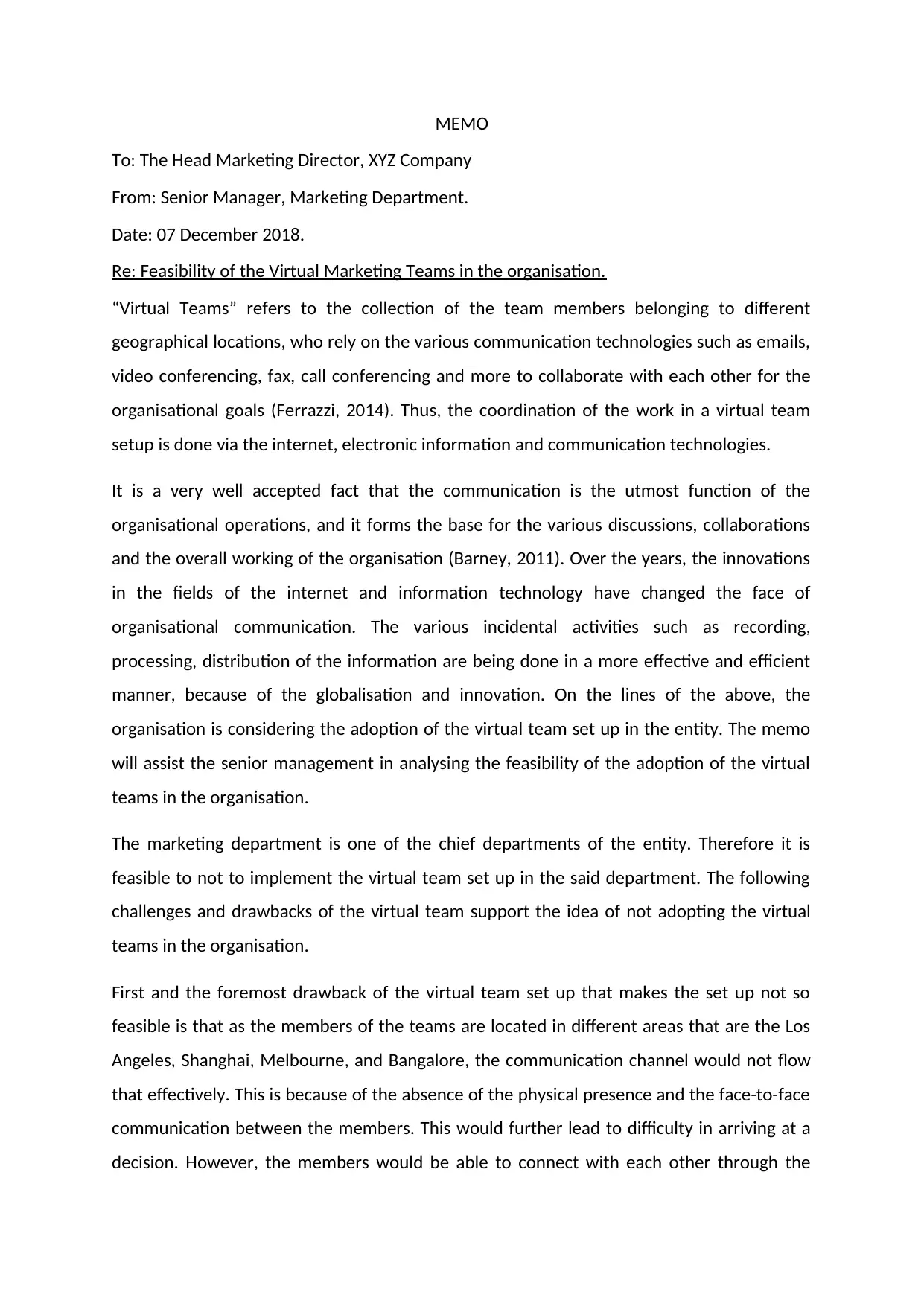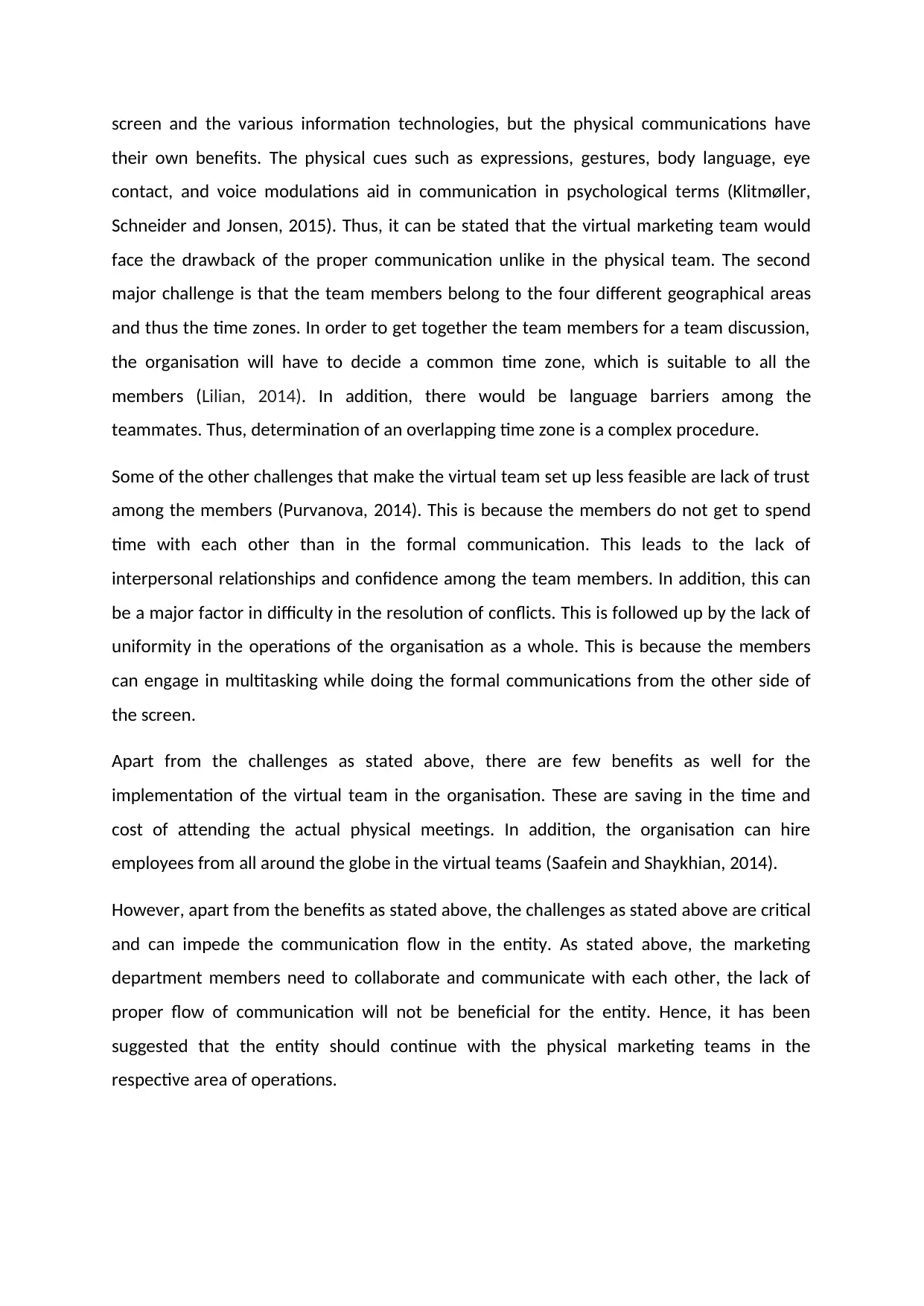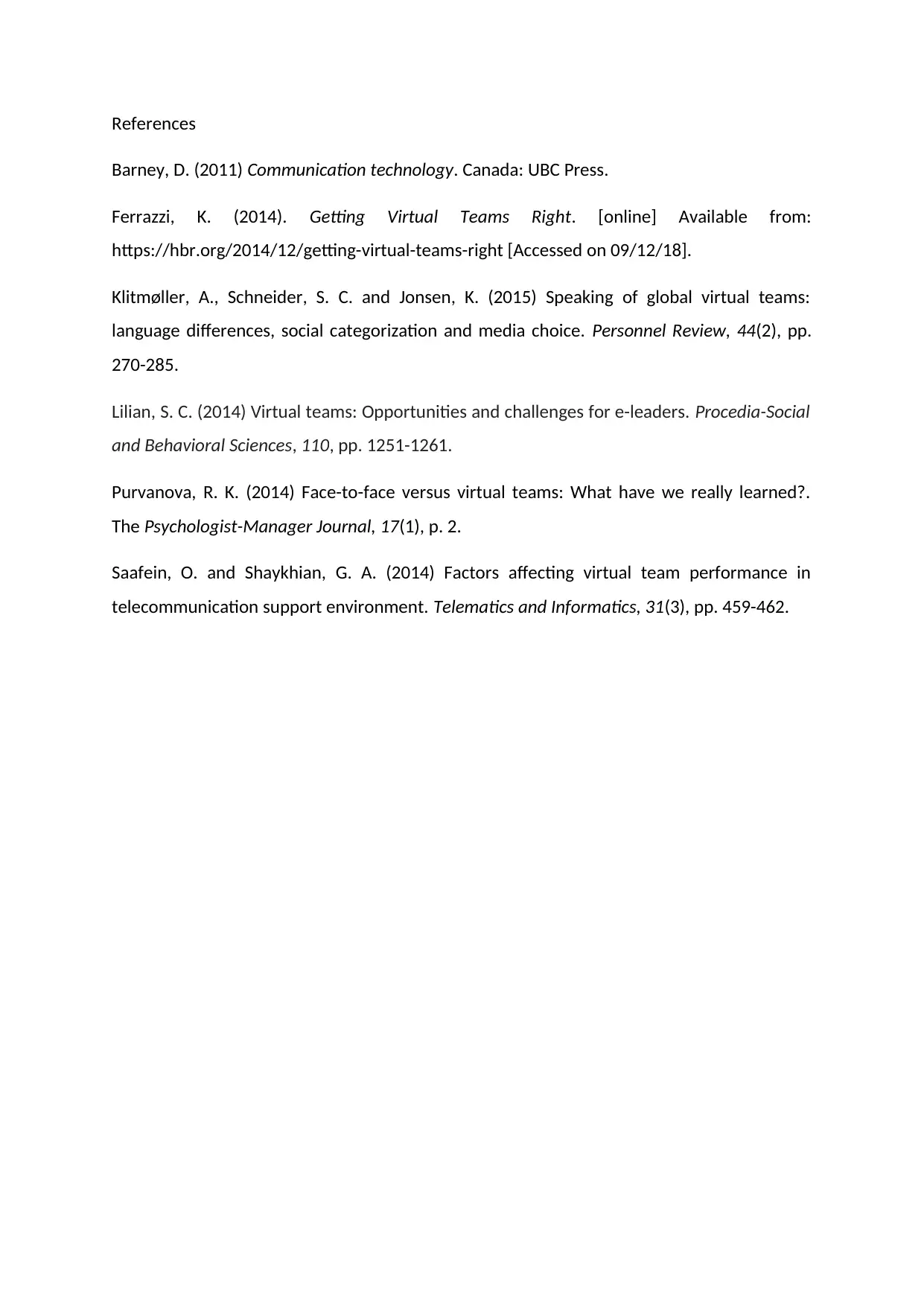XYZ Company: Assessing the Feasibility of Virtual Marketing Teams
VerifiedAdded on 2023/05/28
|4
|1016
|450
Report
AI Summary
This report assesses the feasibility of implementing virtual marketing teams within XYZ Company. It highlights both the challenges and benefits of such a setup, focusing on the marketing department. The report emphasizes the drawbacks, including communication barriers due to geographical distances and time zone differences, which can hinder effective collaboration and decision-making. The absence of face-to-face communication and the resulting lack of non-verbal cues are also noted as potential impediments. While acknowledging potential benefits like cost savings and access to a global talent pool, the report ultimately suggests that XYZ Company should maintain its physical marketing teams due to the critical need for seamless communication and collaboration within the department. Desklib provides access to this and similar solved assignments for students.

07 December 2018
MANAGEMENT COMMUNICATION
MEMO
MANAGEMENT COMMUNICATION
MEMO
Paraphrase This Document
Need a fresh take? Get an instant paraphrase of this document with our AI Paraphraser

MEMO
To: The Head Marketing Director, XYZ Company
From: Senior Manager, Marketing Department.
Date: 07 December 2018.
Re: Feasibility of the Virtual Marketing Teams in the organisation.
“Virtual Teams” refers to the collection of the team members belonging to different
geographical locations, who rely on the various communication technologies such as emails,
video conferencing, fax, call conferencing and more to collaborate with each other for the
organisational goals (Ferrazzi, 2014). Thus, the coordination of the work in a virtual team
setup is done via the internet, electronic information and communication technologies.
It is a very well accepted fact that the communication is the utmost function of the
organisational operations, and it forms the base for the various discussions, collaborations
and the overall working of the organisation (Barney, 2011). Over the years, the innovations
in the fields of the internet and information technology have changed the face of
organisational communication. The various incidental activities such as recording,
processing, distribution of the information are being done in a more effective and efficient
manner, because of the globalisation and innovation. On the lines of the above, the
organisation is considering the adoption of the virtual team set up in the entity. The memo
will assist the senior management in analysing the feasibility of the adoption of the virtual
teams in the organisation.
The marketing department is one of the chief departments of the entity. Therefore it is
feasible to not to implement the virtual team set up in the said department. The following
challenges and drawbacks of the virtual team support the idea of not adopting the virtual
teams in the organisation.
First and the foremost drawback of the virtual team set up that makes the set up not so
feasible is that as the members of the teams are located in different areas that are the Los
Angeles, Shanghai, Melbourne, and Bangalore, the communication channel would not flow
that effectively. This is because of the absence of the physical presence and the face-to-face
communication between the members. This would further lead to difficulty in arriving at a
decision. However, the members would be able to connect with each other through the
To: The Head Marketing Director, XYZ Company
From: Senior Manager, Marketing Department.
Date: 07 December 2018.
Re: Feasibility of the Virtual Marketing Teams in the organisation.
“Virtual Teams” refers to the collection of the team members belonging to different
geographical locations, who rely on the various communication technologies such as emails,
video conferencing, fax, call conferencing and more to collaborate with each other for the
organisational goals (Ferrazzi, 2014). Thus, the coordination of the work in a virtual team
setup is done via the internet, electronic information and communication technologies.
It is a very well accepted fact that the communication is the utmost function of the
organisational operations, and it forms the base for the various discussions, collaborations
and the overall working of the organisation (Barney, 2011). Over the years, the innovations
in the fields of the internet and information technology have changed the face of
organisational communication. The various incidental activities such as recording,
processing, distribution of the information are being done in a more effective and efficient
manner, because of the globalisation and innovation. On the lines of the above, the
organisation is considering the adoption of the virtual team set up in the entity. The memo
will assist the senior management in analysing the feasibility of the adoption of the virtual
teams in the organisation.
The marketing department is one of the chief departments of the entity. Therefore it is
feasible to not to implement the virtual team set up in the said department. The following
challenges and drawbacks of the virtual team support the idea of not adopting the virtual
teams in the organisation.
First and the foremost drawback of the virtual team set up that makes the set up not so
feasible is that as the members of the teams are located in different areas that are the Los
Angeles, Shanghai, Melbourne, and Bangalore, the communication channel would not flow
that effectively. This is because of the absence of the physical presence and the face-to-face
communication between the members. This would further lead to difficulty in arriving at a
decision. However, the members would be able to connect with each other through the

screen and the various information technologies, but the physical communications have
their own benefits. The physical cues such as expressions, gestures, body language, eye
contact, and voice modulations aid in communication in psychological terms (Klitmøller,
Schneider and Jonsen, 2015). Thus, it can be stated that the virtual marketing team would
face the drawback of the proper communication unlike in the physical team. The second
major challenge is that the team members belong to the four different geographical areas
and thus the time zones. In order to get together the team members for a team discussion,
the organisation will have to decide a common time zone, which is suitable to all the
members (Lilian, 2014). In addition, there would be language barriers among the
teammates. Thus, determination of an overlapping time zone is a complex procedure.
Some of the other challenges that make the virtual team set up less feasible are lack of trust
among the members (Purvanova, 2014). This is because the members do not get to spend
time with each other than in the formal communication. This leads to the lack of
interpersonal relationships and confidence among the team members. In addition, this can
be a major factor in difficulty in the resolution of conflicts. This is followed up by the lack of
uniformity in the operations of the organisation as a whole. This is because the members
can engage in multitasking while doing the formal communications from the other side of
the screen.
Apart from the challenges as stated above, there are few benefits as well for the
implementation of the virtual team in the organisation. These are saving in the time and
cost of attending the actual physical meetings. In addition, the organisation can hire
employees from all around the globe in the virtual teams (Saafein and Shaykhian, 2014).
However, apart from the benefits as stated above, the challenges as stated above are critical
and can impede the communication flow in the entity. As stated above, the marketing
department members need to collaborate and communicate with each other, the lack of
proper flow of communication will not be beneficial for the entity. Hence, it has been
suggested that the entity should continue with the physical marketing teams in the
respective area of operations.
their own benefits. The physical cues such as expressions, gestures, body language, eye
contact, and voice modulations aid in communication in psychological terms (Klitmøller,
Schneider and Jonsen, 2015). Thus, it can be stated that the virtual marketing team would
face the drawback of the proper communication unlike in the physical team. The second
major challenge is that the team members belong to the four different geographical areas
and thus the time zones. In order to get together the team members for a team discussion,
the organisation will have to decide a common time zone, which is suitable to all the
members (Lilian, 2014). In addition, there would be language barriers among the
teammates. Thus, determination of an overlapping time zone is a complex procedure.
Some of the other challenges that make the virtual team set up less feasible are lack of trust
among the members (Purvanova, 2014). This is because the members do not get to spend
time with each other than in the formal communication. This leads to the lack of
interpersonal relationships and confidence among the team members. In addition, this can
be a major factor in difficulty in the resolution of conflicts. This is followed up by the lack of
uniformity in the operations of the organisation as a whole. This is because the members
can engage in multitasking while doing the formal communications from the other side of
the screen.
Apart from the challenges as stated above, there are few benefits as well for the
implementation of the virtual team in the organisation. These are saving in the time and
cost of attending the actual physical meetings. In addition, the organisation can hire
employees from all around the globe in the virtual teams (Saafein and Shaykhian, 2014).
However, apart from the benefits as stated above, the challenges as stated above are critical
and can impede the communication flow in the entity. As stated above, the marketing
department members need to collaborate and communicate with each other, the lack of
proper flow of communication will not be beneficial for the entity. Hence, it has been
suggested that the entity should continue with the physical marketing teams in the
respective area of operations.
⊘ This is a preview!⊘
Do you want full access?
Subscribe today to unlock all pages.

Trusted by 1+ million students worldwide

References
Barney, D. (2011) Communication technology. Canada: UBC Press.
Ferrazzi, K. (2014). Getting Virtual Teams Right. [online] Available from:
https://hbr.org/2014/12/getting-virtual-teams-right [Accessed on 09/12/18].
Klitmøller, A., Schneider, S. C. and Jonsen, K. (2015) Speaking of global virtual teams:
language differences, social categorization and media choice. Personnel Review, 44(2), pp.
270-285.
Lilian, S. C. (2014) Virtual teams: Opportunities and challenges for e-leaders. Procedia-Social
and Behavioral Sciences, 110, pp. 1251-1261.
Purvanova, R. K. (2014) Face-to-face versus virtual teams: What have we really learned?.
The Psychologist-Manager Journal, 17(1), p. 2.
Saafein, O. and Shaykhian, G. A. (2014) Factors affecting virtual team performance in
telecommunication support environment. Telematics and Informatics, 31(3), pp. 459-462.
Barney, D. (2011) Communication technology. Canada: UBC Press.
Ferrazzi, K. (2014). Getting Virtual Teams Right. [online] Available from:
https://hbr.org/2014/12/getting-virtual-teams-right [Accessed on 09/12/18].
Klitmøller, A., Schneider, S. C. and Jonsen, K. (2015) Speaking of global virtual teams:
language differences, social categorization and media choice. Personnel Review, 44(2), pp.
270-285.
Lilian, S. C. (2014) Virtual teams: Opportunities and challenges for e-leaders. Procedia-Social
and Behavioral Sciences, 110, pp. 1251-1261.
Purvanova, R. K. (2014) Face-to-face versus virtual teams: What have we really learned?.
The Psychologist-Manager Journal, 17(1), p. 2.
Saafein, O. and Shaykhian, G. A. (2014) Factors affecting virtual team performance in
telecommunication support environment. Telematics and Informatics, 31(3), pp. 459-462.
1 out of 4
Related Documents
Your All-in-One AI-Powered Toolkit for Academic Success.
+13062052269
info@desklib.com
Available 24*7 on WhatsApp / Email
![[object Object]](/_next/static/media/star-bottom.7253800d.svg)
Unlock your academic potential
Copyright © 2020–2025 A2Z Services. All Rights Reserved. Developed and managed by ZUCOL.



